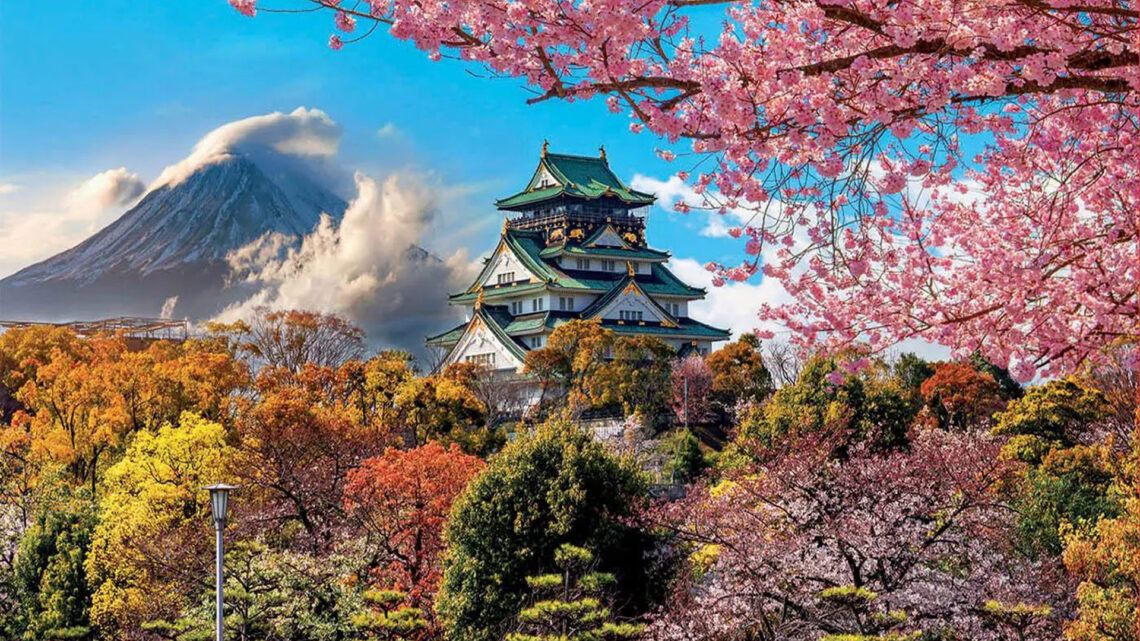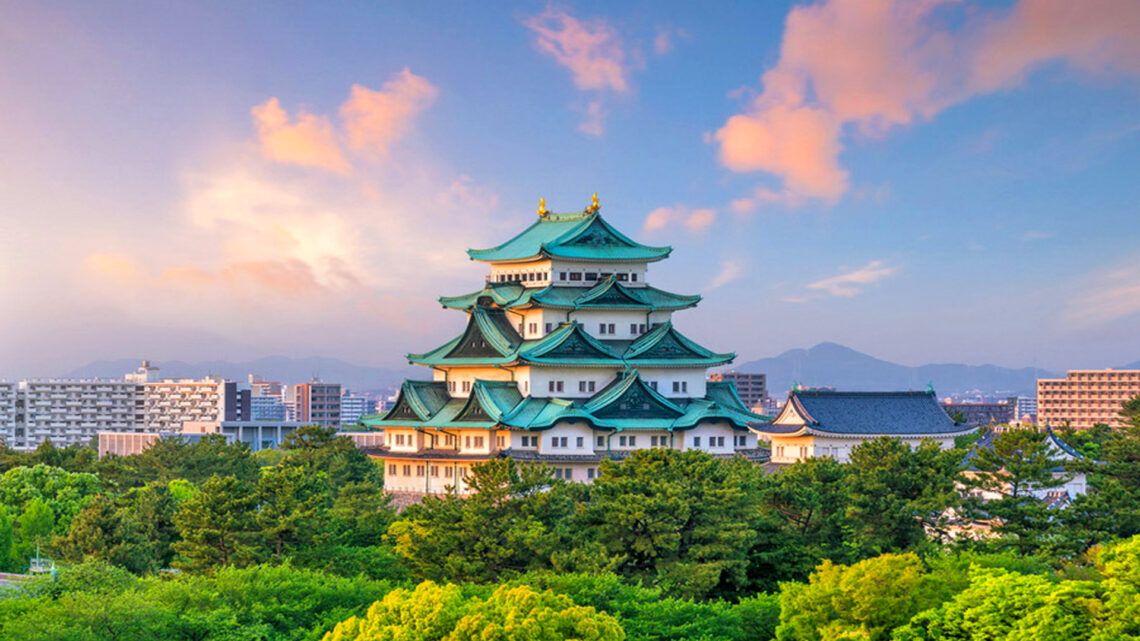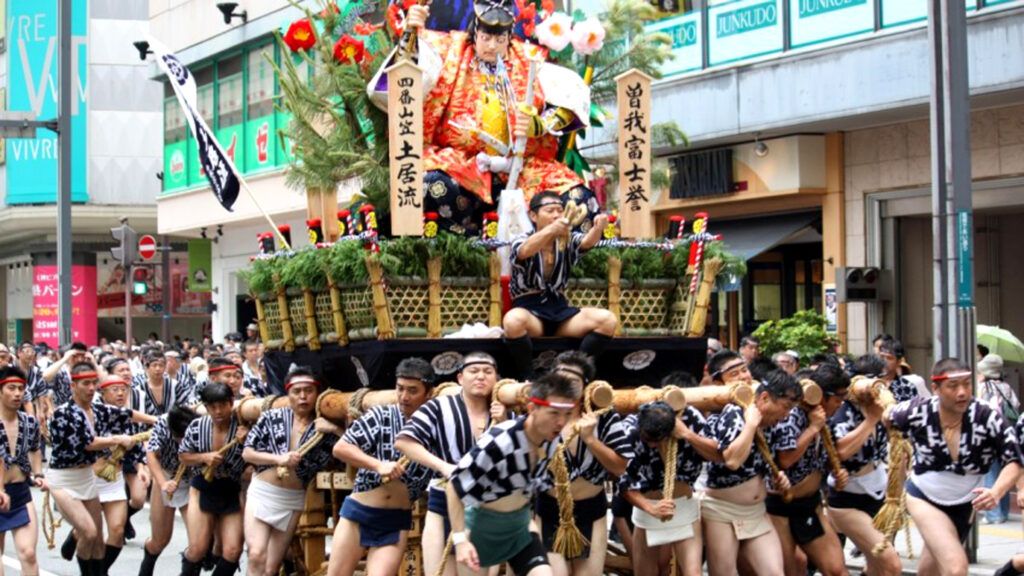
The Hakata Gion Yamakasa is one of the most famous and traditional festivals in Japan, held annually in July in the city of Fukuoka on the southern island of Kyushu. It attracts not only locals but also thousands of tourists from around the world. This colorful and dynamic festival is a symbol of Fukuoka’s cultural identity and has a history spanning over 700 years. It combines elements of Shinto beliefs with spectacular float races, highlighting physical strength, teamwork, and community spirit.
Origins and History

The origins of the Hakata Gion Yamakasa trace back to the 13th century. According to legend, the festival began when the priest Shoichikokushi of the Kushida Shrine prayed and sprinkled holy water over the streets of Hakata to ward off a plague. This ritual purification marked the beginning of a tradition that has evolved and solidified over centuries.
The festival further developed with the inclusion of floats known as “Kakiyama” and “Kazariyama,” which became central elements. These floats are intricately designed, giant structures often depicting mythical or historical scenes and can reach up to 10 meters in height. While the Kazariyama now serve merely as decorative elements, the Kakiyama, about 5 meters high and weighing around a ton, are carried through the streets and raced by participants.
The most famous legend about the origin of the Hakata Gion Yamakasa dates back to 1241. At that time, a severe plague struck Hakata, claiming many lives. A Buddhist priest named Shoichikokushi, who served at the Kushida Shrine, reportedly sat on a wooden pedestal carried by followers during a procession. He sprinkled holy water collected at the shrine onto the streets and houses of Hakata to drive away evil spirits and combat the plague. This act of purification and blessing is seen as the origin of the modern festival, where the floats are carried through the streets to dispel evil and bring good fortune.
Over the centuries, the festival has evolved and taken on various forms. During the Muromachi period (1336–1573) and the Edo period (1603–1868), the festival’s significance grew, and new elements were added. Notably, the introduction of the Yamakasa floats became a central feature of the festival.
Originally simple platforms, these floats became increasingly elaborate and magnificent over time. The Kazariyama, the decorative floats, and the Kakiyama, the portable racing floats, evolved into elaborate artworks depicting scenes from Japanese history, mythology, and folklore. This evolution reflected the growing wealth and artistic skills of the city’s inhabitants.
The Yamakasa floats are divided into two main types: Kazariyama and Kakiyama. The Kazariyama are decorative floats often displayed in shopping centers and public places. They stand about 10 meters tall and are adorned with colorful figures and scenes. These floats are not carried but serve as exhibits showcasing the artistic skill and cultural richness of Fukuoka.
In contrast, the Kakiyama are portable floats carried through the streets during the Oiyama race. These floats are smaller, about 5 meters high, and weigh around a ton. They are also intricately designed, but their primary purpose is participation in the race, where they are carried by teams from different city districts.
During the Edo period, Hakata’s merchants played a crucial role in the festival’s development. As Hakata was a thriving commercial center, the merchants provided financial and organizational support for the festival. They saw the festival as an opportunity to demonstrate their power and influence while also fostering community spirit. The merchants contributed to the splendor of the Yamakasa floats and organized competitions to award the most beautiful and impressive floats. These competitions encouraged artistic expression and craftsmanship among participants, making the festival a showcase of Hakata’s culture and art.
With the Meiji Restoration in 1868 and the subsequent modernization of Japan, the Hakata Gion Yamakasa Festival also underwent changes. During the early Meiji period, many traditional festivals and customs were abolished or altered to make way for new, Western-influenced ideals. However, the Hakata Gion Yamakasa survived these upheavals and adapted to modern circumstances.
In the 20th century, the festival gained further popularity and became a symbol of Fukuoka’s cultural identity. The Yamakasa floats grew increasingly magnificent, and participation in the festival became a prestigious affair passed down through generations. The city government and local organizations began supporting and promoting the festival to preserve it as cultural heritage.
Today, the Hakata Gion Yamakasa Festival is one of the most important and renowned festivals in Japan. It attracts hundreds of thousands of visitors each year and is a vital part of Fukuoka’s cultural and social life. Preparations begin months in advance, and the entire city is involved in the festivities.
The festival consists of various events and ceremonies, culminating in the Oiyama race on July 15. Participants, mostly men from different Fukuoka districts, carry the “Kakiyama” through the streets. Organized into teams called “Nagas,” these teams compete against each other, showcasing their strength, endurance, and teamwork.
In addition to the races, there are many other activities such as parades, music and dance performances, markets, and religious ceremonies. The festival offers a unique opportunity to experience and celebrate Fukuoka’s rich culture and history.
The Hakata Gion Yamakasa Festival is a living example of Japan’s rich cultural tradition. Its origins in legend and historical development reflect the changes and continuities in Japanese society. Today, the festival symbolizes community, tradition, and cultural identity and is an unforgettable experience for all who participate or witness it.
Preparations and Rituals

The preparations for the Hakata Gion Yamakasa begin weeks before the actual festival. The districts of Fukuoka are divided into seven teams, known as “Nagas,” each responsible for building and decorating their own Kakiyama floats. These preparations are a communal effort, involving men, women, and children alike.
One of the initial ceremonies is the “Oiyama-narashi,” a dress rehearsal where participants test their endurance and teamwork. This rehearsal usually takes place on July 12, three days before the main race. It is followed by the “Shudanyamamise,” where the teams parade their magnificent floats through Fukuoka’s main streets to present them to the public.
The festival’s climax is the Oiyama race on July 15, which begins in the early hours of the morning. Precisely at 4:59 AM, the teams start one after another from the Kushida Shrine, led by the beat of a large drum. The route winds through narrow streets and along waterways, requiring not just physical effort but also skill and coordination.
The participants, all men, wear traditional Happi coats and Fundoshi loincloths. They chant rhythmically “Oisa! Oisa!” and are supported by the cheers of spectators along the route. The atmosphere is electrifying, with drums, flutes, and the crowd’s applause accompanying the spectacle.
The Nagare: Team Organization
The city of Fukuoka is divided into seven districts, known as “Nagare,” for the festival: Higashi-Nagare, Nakasu-Nagare, Nishi-Nagare, Doi-Nagare, Ebisu-Nagare, Daikoku-Nagare, and Kakiyama-Nagare. Each district forms a team responsible for the preparation and execution of their own Yamakasa float. These teams comprise men of all ages who often participate in the festivities from childhood.
The Nagare are more than just teams; they are communities bound by their shared history and traditions. The preparations for the festival foster unity and community spirit within each district.
Construction of the Yamakasa Floats
The construction of the Yamakasa floats typically begins in June. The floats are intricately designed, elaborate structures depicting historical and mythical scenes. Experienced craftsmen and artists, who often pass down their knowledge and skills from generation to generation, lead the construction.
The floats consist of a wooden frame adorned with elaborate carvings and painted panels. Figures and scenes from Japanese history, mythology, and folklore are mounted on the float. These figures are carefully carved from wood and painted to ensure the float’s vibrant and colorful aesthetics.
Shudanyamamise: The Float Presentation
On July 1, the official festival begins with the “Shudanyamamise,” a grand parade where the completed Kazariyama floats are pulled through Fukuoka’s streets. This parade offers participants the opportunity to showcase their artistic floats to the public and inspect the other teams’ efforts.
During this parade, participants wear traditional attire, including Happi coats and Fundoshi loincloths, and sing traditional songs accompanied by drums and flutes. The streets of Fukuoka are lined with enthusiastic spectators admiring the magnificent floats and cheering on the participants.
Asayama: Morning Training Runs
In the days leading up to the main festival, from July 10 to July 14, daily morning training runs, known as “Asayama,” take place. These runs start early in the morning and serve to prepare the participants for the physical challenges of the Oiyama race.
During the Asayama, participants carry their Kakiyama floats through the streets, practicing running, turning, and stopping. These training runs are intense, requiring great endurance and teamwork. The participants chant rhythmically “Oisa! Oisa!” and are cheered on by residents and visitors.
Oiyamanarashi: The Dress Rehearsal
On July 12, the “Oiyamanarashi,” a dress rehearsal for the main race on July 15, takes place. This event attracts many spectators eager to get a first impression of the teams’ speed and skill.
During the Oiyamanarashi, teams run the entire course of the Oiyama race. This is an opportunity for participants to test their abilities and make last-minute adjustments to their strategy. It is also an important exercise for organizers to ensure the course is safe and well-marked.
Nagaregaki: Special Rituals and Performances
In addition to the main preparations and training runs, each Nagare conducts special rituals and performances to strengthen their community and spiritually prepare for the festival. These include purification rituals, prayers, and ceremonies at the Kushida Shrine, the festival’s spiritual center.
These rituals often involve carrying smaller, portable shrines called “Omikoshi” through the streets and singing prayer songs. Participants seek protection and blessings for the festival and the community.
Carrying the Water: Mizuhikiyama
Another important ritual is the carrying of holy water, known as “Mizuhikiyama.” This ritual commemorates the legendary origin of the festival, where the priest Shoichikokushi sprinkled holy water on the streets to ward off the plague. Participants carry water in buckets and sprinkle it on the streets and spectators to symbolically purify and bless them.
The Climax: Oiyama Race
The highlight of the Hakata Gion Yamakasa Festival is the Oiyama race on July 15. This spectacular event begins early in the morning and attracts thousands of spectators. Precisely at 4:59 AM, at sunrise, the teams start one after another from the Kushida Shrine.
The Start at Kushida Shrine
The start at Kushida Shrine is a highly emotional and spiritual moment. Participants gather at the shrine to pray for protection and blessings before taking up their Yamakasa floats. A large drum signals the start, and the first group sets off, followed by the other teams at fixed intervals.
The Course and the Challenge
The racecourse winds through the narrow streets of Hakata, passing important historical and cultural sites. The course is about five kilometers long and requires not only physical strength but also skill and teamwork. Participants must maneuver their heavy floats through tight corners and over bridges, accompanied by the cheers of the spectators.
The Significance of the Race
The Oiyama race is more than just a competition; it is an expression of community, tradition, and cultural identity. Participants, often from different generations of the same family, carry the pride of their community on their shoulders. The effort and sweat they put into the race symbolize their dedication and respect for the traditions of their ancestors.
The preparations and rituals of the Hakata Gion Yamakasa Festival are an essential part of this impressive cultural event. They foster community spirit, preserve ancient traditions, and prepare participants for the physical and spiritual challenges of the Oiyama race. The festival is a living example of Fukuoka’s rich cultural history and offers an unforgettable experience for all who participate in or witness it.
Significance and Influence
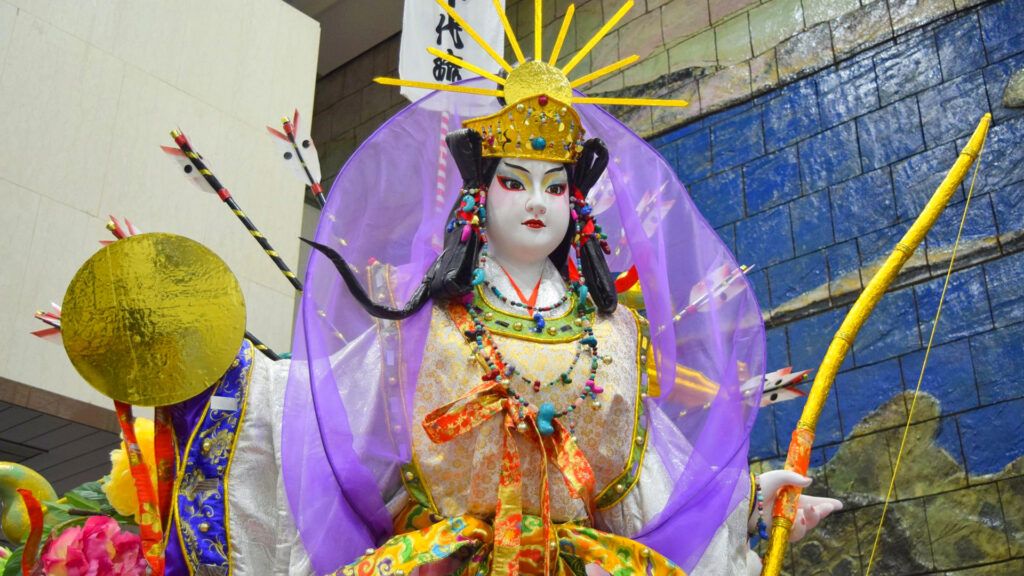
The Hakata Gion Yamakasa is more than just a festival; it is an expression of the cultural identity and community spirit of Fukuoka. Participation in the preparations and the race itself is an honor passed down from generation to generation. It strengthens the bonds within the community and fosters a strong sense of togetherness.
Additionally, the festival has economic significance. It attracts tourists, boosting the local economy, and provides a platform for showcasing traditional crafts and regional specialties. The Hakata Gion Yamakasa exemplifies how traditions can be kept alive and celebrated in the modern world.
The Hakata Gion Yamakasa Festival is a vivid example of preserving and passing down centuries-old traditions. Celebrated continuously since the 13th century, the festival has retained its essential features and rituals despite modernization and globalization. Participation in the festival is a way for Fukuoka’s residents to celebrate and strengthen their cultural identity.
The intricate Yamakasa floats are masterpieces of traditional Japanese craftsmanship. The construction and decoration of these floats require great skill and creativity. The festival offers a platform for craftsmen to showcase and develop their skills, promoting the preservation of traditional craft techniques and artistic expressions.
The festival promotes community spirit and social cohesion. The preparations and execution of the festival require collaboration and commitment from many people across different neighborhoods and age groups. This collective effort strengthens social bonds and the sense of belonging within the community.
Participation in the Hakata Gion Yamakasa is often passed down through generations. Families participate together in the preparations and the race, creating a strong bond between generations. Children and young people learn the values and traditions of the festival from their parents and grandparents, contributing to cultural continuity.
The Hakata Gion Yamakasa attracts thousands of tourists from Japan and abroad every year. These visitors stimulate the local economy by staying in hotels, dining in restaurants, and shopping at local businesses. The tourism industry significantly benefits from the festival’s appeal, leading to economic growth in the region.
The Hakata Gion Yamakasa is deeply rooted in Shinto beliefs. Many of the rituals and ceremonies conducted during the festival have religious significance and serve the spiritual purification and protection of the community. Participation in these ceremonies strengthens the faith and spiritual connection of the people.
The Hakata Gion Yamakasa Festival also serves as an important educational resource for younger generations. Schools and educational institutions in Fukuoka often integrate the festival into their curriculum to teach students about the importance of cultural traditions and local history. Field trips to the floats and lectures by festival participants are common activities.
The Hakata Gion Yamakasa attracts not only Japanese visitors but also international tourists and cultural enthusiasts. This international participation promotes intercultural exchange and understanding between different cultures. The festival acts as an ambassador of Japanese culture and helps to make Fukuoka known worldwide.
Fukuoka maintains friendly relations with various cities worldwide, and the Hakata Gion Yamakasa Festival plays a role in strengthening these relationships. Delegations from sister cities are often invited to participate in or observe the festival, fostering cultural exchange and diplomatic relations.
Travel and Accommodation
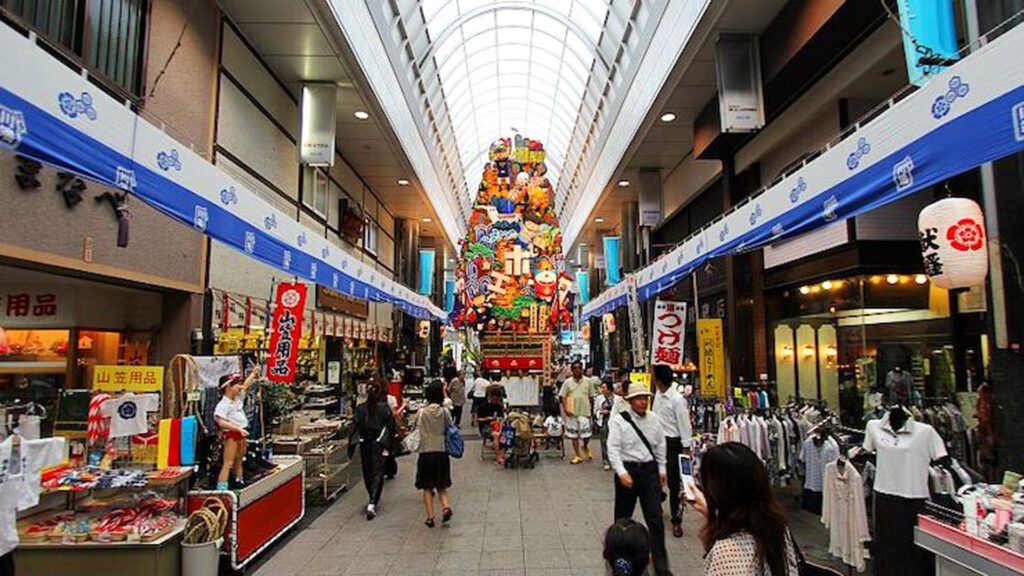
The Hakata Gion Yamakasa Festival attracts thousands of visitors each year who come to experience the vibrant culture and fascinating festivities. Proper planning of travel and accommodation is crucial to make the visit as enjoyable as possible. Here is detailed information on various travel options and accommodation choices in Fukuoka.
By Airplane
Fukuoka is easily accessible by airplane, thanks to Fukuoka Airport (FUK), located just a few kilometers from the city center. The airport offers numerous domestic and international connections, making it convenient to travel from many parts of Japan and the world.
From the airport to the city center: The simplest way to get from the airport to the city center is by subway. The Kuko Line (Airport Line) connects the airport directly to Hakata Station in about 5 minutes. Alternatively, taxis and buses are available, providing quick and convenient transportation to the city center.
By Train
Fukuoka is a major transportation hub in the Japanese Shinkansen network. Hakata Station is the city’s central station, offering numerous connections to other major cities in Japan.
Shinkansen: Hakata Station is connected to the Tokaido and Sanyo Shinkansen lines, providing fast connections to Tokyo, Osaka, Hiroshima, and other key cities. The trip from Tokyo to Fukuoka takes about 5 hours by Nozomi Shinkansen.
Limited Express and regional trains: In addition to the Shinkansen, there are many Limited Express trains and regional connections linking Fukuoka with surrounding areas in Kyushu.
By Bus
Long-distance buses are an affordable alternative for traveling to Fukuoka. Numerous bus companies offer connections to and from many cities in Japan.
Bus terminals: The main bus terminal in Fukuoka is near Hakata Station, allowing easy onward travel within the city. Travel times vary depending on the departure point but provide a comfortable and cost-effective way to reach Fukuoka.
By Car
For those who prefer flexible travel, driving is another option. Fukuoka is accessible via a well-developed road network.
Car rental: Fukuoka has numerous car rental agencies offering a variety of vehicles. However, driving in the city can be challenging during the festival due to road closures and increased traffic.
Accommodation in Fukuoka
Fukuoka offers a wide range of accommodation options to meet the needs and budgets of all visitors. Here are some of the most popular choices:
Hotels
Fukuoka has a variety of hotels, ranging from luxurious 5-star hotels to budget-friendly options.
Luxury hotels: For visitors seeking the utmost comfort, hotels like the Grand Hyatt Fukuoka and the Hilton Fukuoka Sea Hawk offer top-notch amenities and services. These hotels are centrally located, providing easy access to the festival activities.
Mid-range hotels: Hotels such as Hotel Nikko Fukuoka and Hakata Excel Hotel Tokyu offer comfortable accommodations at moderate prices. They are ideal for travelers seeking a balance between comfort and cost.
Ryokan and Minshuku
For an authentic Japanese experience, Ryokan and Minshuku offer traditional accommodations with tatami mats, futons, and often public baths (onsen).
Ryokan: These traditional inns provide a unique atmosphere and hospitality. Staying at a Ryokan like Kashima Honkan allows guests to experience Japanese culture and lifestyle up close.
Minshuku: These family-run guesthouses offer a cheaper alternative to Ryokan and are ideal for travelers seeking a personal and cozy stay.
Hostels and Capsule Hotels
For backpackers and budget-conscious travelers, hostels and capsule hotels offer affordable lodging options.
Hostels: Fukuoka has a growing number of hostels offering dormitories and private rooms at reasonable prices. Hostels like Khaosan Fukuoka and Fukuoka Hana Hostel are popular among young travelers.
Capsule hotels: These futuristic accommodations provide small but functional sleeping pods and are a unique lodging option. Capsule hotels like Nine Hours Hakata Station offer clean and modern facilities at low prices.
Vacation Rentals and Airbnb
For travelers who prefer more independence and space, vacation rentals and Airbnb options are ideal. These accommodations offer the opportunity to stay in a home-like environment, making them especially suitable for longer stays or families.
Vacation rentals: Platforms like Airbnb offer a variety of apartments and houses for rent, often equipped with kitchens and living rooms. This allows guests to feel at home and prepare their meals.
Tips for Booking Accommodation
Given the large number of visitors attracted by the Hakata Gion Yamakasa Festival, it is advisable to book accommodation as early as possible. Many of the best hotels and Ryokan get booked quickly.
Central location: To conveniently follow the festival activities, consider staying near Hakata Station or in the Tenjin area. These locations offer easy access to major event sites and good public transport connections.
Check reviews: Before booking accommodation, it is helpful to read reviews and comments from previous guests to get an idea of the quality and service of the lodging.
Travel and accommodation for the Hakata Gion Yamakasa Festival in Fukuoka can be smoothly arranged with some planning and preparation. The city offers a variety of travel options and lodging choices to meet the needs and budgets of all visitors. Whether you stay in a luxurious hotel, enjoy the traditional hospitality of a Ryokan, or try the unique experience of a capsule hotel, Fukuoka has something for everyone. A well-planned stay will help you fully enjoy the festival and experience the fascinating culture and history of Fukuoka.
My Conclusion:
The Hakata Gion Yamakasa Festival is a cultural gem that reflects Fukuoka’s rich history, artistic creativity, and community spirit. Its significance extends far beyond the city limits, impacting various aspects of social, economic, and cultural life. By preserving ancient traditions and fostering a sense of community, the festival makes an invaluable contribution to the region’s cultural identity and social cohesion. It stands as a vibrant testament to how deeply rooted traditions can continue to live and thrive in a modern society.


